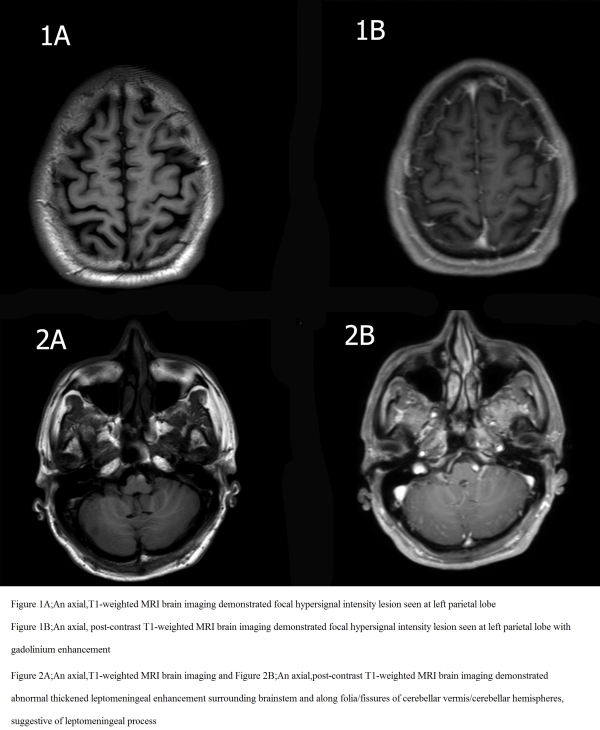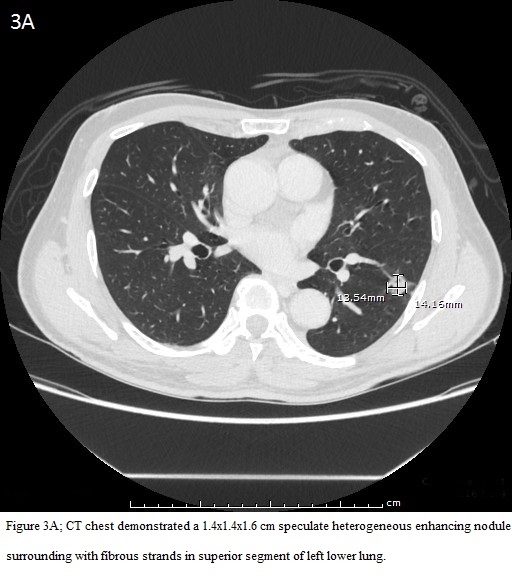Session Information
Date: Tuesday, June 21, 2016
Session Title: Myoclonus
Session Time: 12:30pm-2:00pm
Location: Exhibit Hall located in Hall B, Level 2
Objective: To describe a 56-year-old man who presented with OMA due to disseminated cryptococcosis.
Background: Opsoclonus-myoclonus-ataxia syndrome (OMA) is a rare neurological syndrome,characterized by a rapid onset of generalized myoclonus with multidirectional chaotic eye movements,and less frequently cerebellar ataxia.While the association of OMA and paraneoplastic syndrome is well described,OMA may occur as a result of various viral agents.
Methods: A 56-year old Thai male presented with a 1-month fever and diffuse headache.The positional-unrelated headache was mild persistent.He was admitted for inguinal hernia surgery but the examination showed generalized action myoclonus affecting his hands when outstretched and bouncing gait when he walked.He described intermittent oscillopsia ,truncal ataxia, and dysdiadochokinesia bilaterally.He walked with a wide-based and sway laterally.Routine laboratory investigations were normal.Lumbar tap indicated pressure of 18 cmH2O,with pleocytosis (WBC = 111 cells, Lym 73%), protein of 270mg/dL, and a low glucose level of 13 mg/dL.An CSF study was positive for cyptococcal antigen (CSF 1:2048, serum 1:512),and the culture was Cryptococcus neoformans.Serum Anti-Gamma interferon was positive (3.354; negative control 0.673, positive control 2.933).CSF study of viral antibodies were all negative.MRI brain revealed a leptomeningeal enhancement involving brainstem and cerebellum and a 5-mm ring-enhancing lesion suspected of cryptococcoma with surrounding edema in the left postcentral gyrus .An enhancing lung nodule consistent with cryptococcoma was identified on chest CT
.An enhancing lung nodule consistent with cryptococcoma was identified on chest CT .
.
Results: We described a seronegative patient with disseminated cryptococcosis who presented with OMA.Despite no evidence of immunological deficiency, we suspected anti-interferon gamma might be indicated of altered immunological status due to an evidence from in-vivo study found increasing level of interferon gamma for cryptococcal infection clearance. An increasing of immune regulation might explain OMA syndrome.While infectious or parainfectious causes of OMA has been reported mainly with virus, we are not aware of any literature documenting the OMA with cryptococcal infection.
| Pathogen | Ref/number of patients | Age/sex | Diagnosis | Ocular signs | Myoclonus | Cerebellar ataxia | Lab investigations |
| Virus | 1Wiest et al. 3 cases | 45 F | Respiratory tract infection (Enterovirus) | Ocular flutter | No | Yes | Antibody titres to Enterovirus |
| 33 F | Respiratory tract infection | Ocular flutter | No | Yes | All negative including viral studies | ||
| 28 F | Respiratory tract infection | Ocular flutter | No | Yes | All negative including viral studies | ||
| 2Alshekhlee et al. 1 case | 53 M | West nile virus encephalitis | Opsoclonus | Yes | Yes | IgM antibodies to west nile virus positive in CSF | |
| 3Verma et al. 1 case | 50 M | EBV infection | Opsoclonus | Yes | Yes | PCR for EBV genome in csf and blood were positive | |
| 4Kanjanasut et al. 2cases | 25 M | HIV infection | Opsoclonus | Yes | Yes | HIV antibody positive | |
| 39 M | HIV infection | Opsoclonus | Yes | Yes | HIV infection CD4: increased from 415 to 552cells/uL ,Viral load <50copies/ml | ||
| 5Zaganas et al. 1 case | 30 M | CMV encephalitis | Opsoclonus | Yes | No | Positive PCR and high IgG titers in CSF and rising serum IgM and IgG titers of CMV | |
| 6Ai et al. 2 cases | 30 M | Dengue fever | Opsoclonus | Yes | No | Positive serum dengue IgM | |
| 10 M | Dengue shock syndrome | Opsoclonus | Yes | Yes | Positive dengue IgM and NS1 antigen | ||
| Bacteria | 7Peter et al. 1 case | 40 F | Lyme disease | Opsoclonus | Yes | Yes | [uarr]B.burgdorferi IgM positive in CSF |
| 8Flabeau et al. 1 case | 62 M | Salmonellosis | Ocular flutter | Yes | Yes | Stool culture positive for salmonella enterica | |
| 9Dassan et al. 1 case | 31 F | Streptococcal infection | Opsoclonus | Yes | No | ASOT = 400 U/mL | |
| Post-vaccination | 10Lapenna et al. 1 case | 30 F | Post-vaccinic (vaccine) | Opsoclonus | Yes | No | All negative |
Conclusions: We reported the first case of OMA as a result of cryptococcosis in a seronegative patient.The development of OMA is likely to be related to altered immune status.
To cite this abstract in AMA style:
K. Sakdisornchai, J. Sringean, O. Jitkritsadakul, R. Bhidayasiri. Opsoclonus myoclonus ataxia syndrome in a seronegative patient with disseminated cryptococcosis: The first case report [abstract]. Mov Disord. 2016; 31 (suppl 2). https://www.mdsabstracts.org/abstract/opsoclonus-myoclonus-ataxia-syndrome-in-a-seronegative-patient-with-disseminated-cryptococcosis-the-first-case-report/. Accessed January 7, 2026.« Back to 2016 International Congress
MDS Abstracts - https://www.mdsabstracts.org/abstract/opsoclonus-myoclonus-ataxia-syndrome-in-a-seronegative-patient-with-disseminated-cryptococcosis-the-first-case-report/
